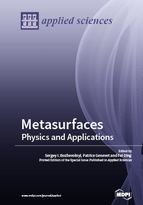Metasurfaces: Physics and Applications
A special issue of Applied Sciences (ISSN 2076-3417). This special issue belongs to the section "Nanotechnology and Applied Nanosciences".
Deadline for manuscript submissions: closed (15 July 2018) | Viewed by 71352
Special Issue Editors
Interests: nano-optics; plasmonics; nanophotonics; quantum optics
Special Issues, Collections and Topics in MDPI journals
Interests: plasmonics; metasurfaces; transformation optics; semiconductors
Special Issues, Collections and Topics in MDPI journals
Interests: nano-optics; plasmonics; nanophotonics; quantum optics
Special Issues, Collections and Topics in MDPI journals
Special Issue Information
Dear Colleagues,
Metasurfaces, the two-dimensional analog of metamaterials, have attracted progressively increasing attention in recent years due to their planar configurations and thus ease of fabrication, while enabling an unprecedented control over optical fields. The phase, amplitude, polarization, helicity and even angular momentum of the reflected and transmitted optical fields can be controlled at will by tailoring optically thin planar arrays of resonant subwavelength elements arranged in a periodic or aperiodic manner. As a result, numerous applications and fascinating devices have been realized by designed metasurfaces, including beam deflectors, wave plates, flat lenses, vortex beam generation, holograms and surface-wave couplers.
The aim of this special issue is to attract world-leading researchers in the area of metasurfaces in an effort to highlight the latest exciting developments, discuss the underlying physics of various configurations used, and promote concrete applications of metasurfaces. The accepted contributions will include theoretical considerations, experimental verifications, and proof-of-concept applications.
Prof. Dr. Sergey I. Bozhevolnyi
Dr. Patrice Genevet
Dr. Fei Ding
Guest Editors
Manuscript Submission Information
Manuscripts should be submitted online at www.mdpi.com by registering and logging in to this website. Once you are registered, click here to go to the submission form. Manuscripts can be submitted until the deadline. All submissions that pass pre-check are peer-reviewed. Accepted papers will be published continuously in the journal (as soon as accepted) and will be listed together on the special issue website. Research articles, review articles as well as short communications are invited. For planned papers, a title and short abstract (about 100 words) can be sent to the Editorial Office for announcement on this website.
Submitted manuscripts should not have been published previously, nor be under consideration for publication elsewhere (except conference proceedings papers). All manuscripts are thoroughly refereed through a single-blind peer-review process. A guide for authors and other relevant information for submission of manuscripts is available on the Instructions for Authors page. Applied Sciences is an international peer-reviewed open access semimonthly journal published by MDPI.
Please visit the Instructions for Authors page before submitting a manuscript. The Article Processing Charge (APC) for publication in this open access journal is 2400 CHF (Swiss Francs). Submitted papers should be well formatted and use good English. Authors may use MDPI's English editing service prior to publication or during author revisions.
Keywords
-
Physics of metasurfaces
-
Reflective metasurfaces
-
Dielectric metasurfaces
-
Pancharatnam-Berry metasurfaces
-
Nonlinear metasurfaces
-
Multi-functional metasurfaces
-
Free form and conformal metasurfaces
-
Metasurface-based devices and applications






